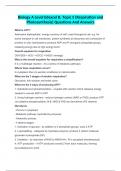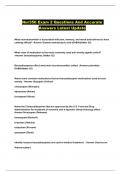-
1. Exam (elaborations) - Med-surg ii hesi test bank questions and answers 2022
-
2. Exam (elaborations) - 2023 hesi ob/maternity v 1 |100 questions and correct answers
-
3. Exam (elaborations) - 2020 hesi ob/maternity v 2
-
4. Exam (elaborations) - 2020 hesi exit v1 160 q&a|all correct|
-
5. Exam (elaborations) - Med surg hesi version 2 | graded a+
-
6. Exam (elaborations) - Med surg hesi version 1.
-
7. Exam (elaborations) - Hesi exit rn exam over 700 questions, answers rationale new 2019/2020 latest 100%.
-
8. Exam (elaborations) - Nurs 220 hesi maternity practice questions
-
9. Exam (elaborations) - Hesi test bank-fundamentals completely answered
-
10. Exam (elaborations) - Exit hesi info bank rationale 2023
-
11. Exam (elaborations) - Hesi rn exit practice test 1 answered 2023
-
12. Exam (elaborations) - Med surg test bank ( red hesi test bank med-surg and other resources) questions and ...
-
13. Exam (elaborations) - Maternity hesi test bank (combined red hesi and other sources) answered
-
14. Exam (elaborations) - Exit hesi (testing, leadership, advanced clinical concepts, and medical-surgical) que...
-
15. Exam (elaborations) - Diagnostic testing hesi prep- adult care questions correctly answered!!!
-
16. Exam (elaborations) - Safety hesi prep adult care questions and answers
-
17. Exam (elaborations) - Adult care hesi prep questions- culture questions and answers 100% answered
-
18. Exam (elaborations) - Hygiene/sleep/elimination hesi prep adult care
-
19. Exam (elaborations) - Adult care hesi prep- acid/base questions and answers
-
20. Exam (elaborations) - Diagnostic imaging hesi test prep
-
21. Exam (elaborations) - hygiene/sleep/elimination hesi prep adult care
-
22. Exam (elaborations) - Hesi fundamentals practice exam questions and answers
-
23. Exam (elaborations) - Ap biology ch 8 - photosynthesis - test questions and answers 100% accurate
-
24. Exam (elaborations) - Biology final - protein synthesis (t&t)
-
25. Exam (elaborations) - Verified *authentic* 2023 hesi rn med surg exam v2 study guide notes test bank & scre...
-
26. Exam (elaborations) - Med surg hesi exit exam/latest 2023/test bank
-
27. Exam (elaborations) - Hesi pediatric exam questions and updated answers
-
28. Exam (elaborations) - Aqa a level biology - photosynthesis questions and answers
-
29. Exam (elaborations) - Biology a level edexcel b, topic 5 (respiration and photosynthesis) questions and ans...
-
30. Exam (elaborations) - Hesi a2 maths with solved answers v1 only
-
31. Exam (elaborations) - Hesi a2 critical thinking questions. 124 questions and answers with&tab; rationale. rated...
-
32. Exam (elaborations) - Hesi a2 critical thinking rationale 2024&tab; &tab;
-
33. Exam (elaborations) - Hesi-a2-grammar-vocabulary questions and answers
-
34. Exam (elaborations) - Hesi a2 reading passages versions 1 2 with answers
-
35. Exam (elaborations) - Hesi a2 v2 grammar, vocab, reading, & math questions with answers).
-
36. Exam (elaborations) - Hesi anatomy and physiology exam questions and answers top-rated and graded a
-
37. Exam (elaborations) - Hesi grammar v1 questions and complete solution
-
38. Exam (elaborations) - Hesi-math-questions-with-answers-all-correct study guide
-
39. Exam (elaborations) - Hesi math v1 v2 questions and answers
-
40. Exam (elaborations) - Hesi vocabulary & grammar questions with correct answers
-
41. Exam (elaborations) - Hesi a2 critical thinking questions
-
42. Exam (elaborations) - Hesi pn exit exam v3 110 questions and answer(s)
-
43. Exam (elaborations) - Rn exit v2 test ****a+ hesi med surg real exit exam with ngn updated latest solutions
-
44. Exam (elaborations) - 2024 hesi maternity ob exam version 3 latest all 55 questions and correct answers |al...
-
45. Exam (elaborations) - Ngn hesi a2 exit exam 2023- 2024 chamberlainuniversity latest exam (guaranteedpass)
-
46. Exam (elaborations) - Hesi pn exit exam questions with correct answers 2023 update| verified and graded a+
-
47. Exam (elaborations) - Hesi lpn exit exam merged from 2019/2020&2021 best for 2022/2023 actual exam prep
-
48. Exam (elaborations) - Pn hesi exit v2 exam, 160 100% verified questions and answers latests updated 2024. d...
-
49. Exam (elaborations) - 2023/2024 hesi bank fundamentals exam tests updated questions
-
50. Exam (elaborations) - New comprehensive hesi exit rn exam set(15exam sets, 2500 + q & a, latest updated 202...
-
Show more





